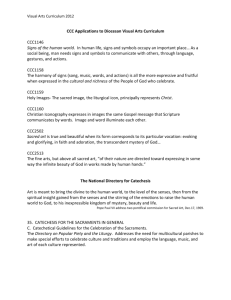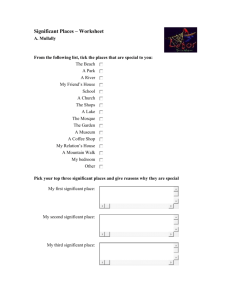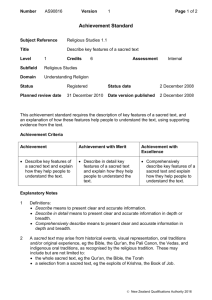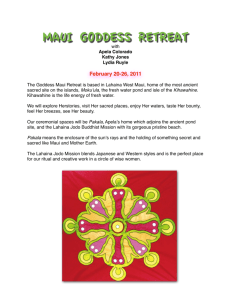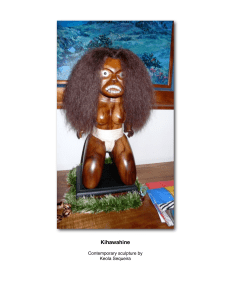Tales from the Night Rainbow
advertisement
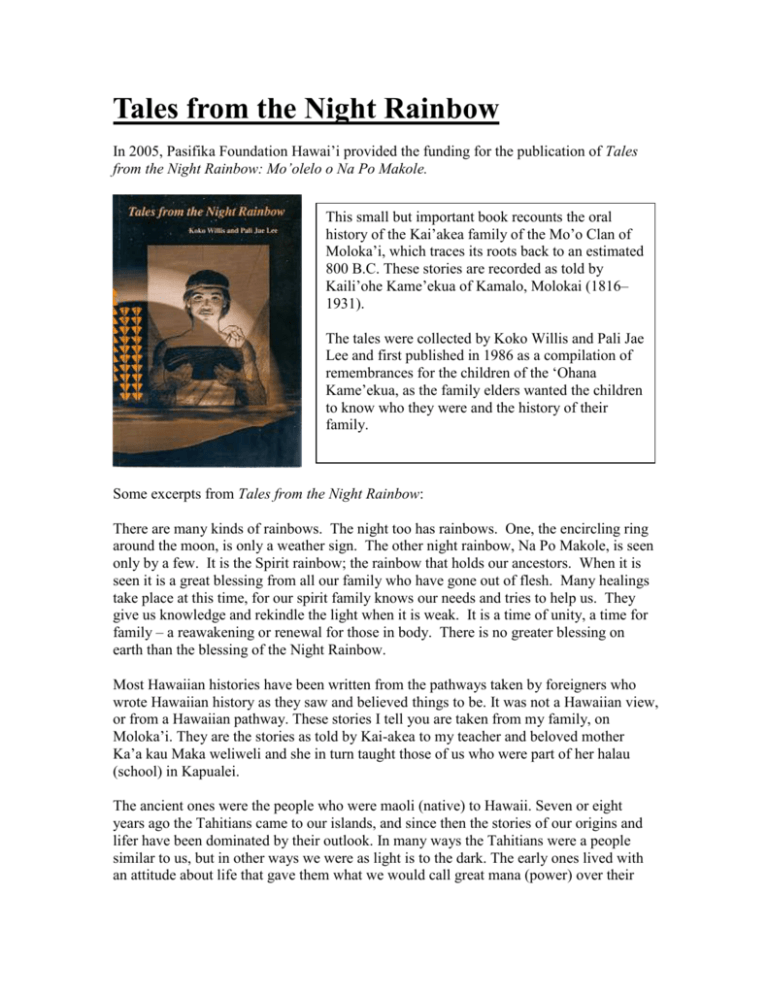
Tales from the Night Rainbow In 2005, Pasifika Foundation Hawai’i provided the funding for the publication of Tales from the Night Rainbow: Mo’olelo o Na Po Makole. This small but important book recounts the oral history of the Kai’akea family of the Mo’o Clan of Moloka’i, which traces its roots back to an estimated 800 B.C. These stories are recorded as told by Kaili’ohe Kame’ekua of Kamalo, Molokai (1816– 1931). The tales were collected by Koko Willis and Pali Jae Lee and first published in 1986 as a compilation of remembrances for the children of the ‘Ohana Kame’ekua, as the family elders wanted the children to know who they were and the history of their family. Some excerpts from Tales from the Night Rainbow: There are many kinds of rainbows. The night too has rainbows. One, the encircling ring around the moon, is only a weather sign. The other night rainbow, Na Po Makole, is seen only by a few. It is the Spirit rainbow; the rainbow that holds our ancestors. When it is seen it is a great blessing from all our family who have gone out of flesh. Many healings take place at this time, for our spirit family knows our needs and tries to help us. They give us knowledge and rekindle the light when it is weak. It is a time of unity, a time for family – a reawakening or renewal for those in body. There is no greater blessing on earth than the blessing of the Night Rainbow. Most Hawaiian histories have been written from the pathways taken by foreigners who wrote Hawaiian history as they saw and believed things to be. It was not a Hawaiian view, or from a Hawaiian pathway. These stories I tell you are taken from my family, on Moloka’i. They are the stories as told by Kai-akea to my teacher and beloved mother Ka’a kau Maka weliweli and she in turn taught those of us who were part of her halau (school) in Kapualei. The ancient ones were the people who were maoli (native) to Hawaii. Seven or eight years ago the Tahitians came to our islands, and since then the stories of our origins and lifer have been dominated by their outlook. In many ways the Tahitians were a people similar to us, but in other ways we were as light is to the dark. The early ones lived with an attitude about life that gave them what we would call great mana (power) over their surroundings, but it is really the power of love and kinship working through the feelings of the objects we live among. It was the belief of our family line that we had been here from the beginning. People had gone out from our land to the East and to the West, and populated other lands. We had chants that told of such migrations from our islands. We taught by stories and parables. One of the earliest and most important to us was: Each child born has at birth, a Bowl of perfect Light. If he tends his Light it will grow in strength and he can do all things – swim with the shark, fly with the birds, know and understand all things. If, however, he becomes envious or jealous, he drops a stone into his Bowl of Light and some of the Light goes out. Light and the stone cannot hold the same space. If he continues to put stones in the Bowl of Light, the Light will go out and he will become a stone. A stone does not grow, nor does it move. If at any time he tires of being a stone, all he needs to do is turn the bowl upside down and the stones will fall away and the Light will grow once more. The stories or parables were teachings and reminders. The maoli had stories of vines, trees, seeds, fish, earth, sea and sky: the things that were common to the people and that they understood. When a child began to speak, the family began to teach him about the world of which he was a part.” * Aloha is being a part of all and all being a part of me. * When there is pain - it is my pain. * When there is joy - it is mine also. * I respect all that is as part of the Creator and part of me. * I will not willfully harm anyone or anything. * When food is needed I will take only my need and explain why it is being taken. * The earth, the sky, the sea are mine to care for, to cherish and to protect. * This is Hawaiian - This is Aloha! The ancient ones believed that all time is now and that we are each creators of our life's conditions. We create ourselves and everything that becomes a part of our lives. Any situation in which we might find ourselves is brought about by learning the many pathways of life. When we wish to change our circumstances, all we have to do is release our present condition. It will be gone. On the other hand, if we find it useful to continue, we can hang on to the problem and not let it go. From the time I was quite small I realized there was something different where I was concerned. No one was allowed to touch my clothing. I knew I had a sacred name that had great mana (strength or power) but I did not know what it was. Sacred names were not told to us until the family elders decided the name was correct. This didn't happen with some until they had been grown for many years. Sometimes the name was not told until the death of the one who gave it. Sacred names were just that - sacred, and not to be fooled with. Only one person alive could carry a particular sacred name at one time. To give a child a sacred name of one still in body was to welcome disaster to the child and to the parents. To name a child with the known name of another (one who was loved and honored) was done often. In this case something was added such as opio (junior) to show that this child had been named for the elder of the same name. We had many Kaili's in our family - all with different endings. My sacred name was mine alone and I would not know it until the time was right. The tradition of carrying the name of some one of your family line, now deceased, was done if the elders felt a certain person had returned to flesh. At other times, it was to bring the strength and wisdom of that family member back into flesh (almost a "wishing it so" type of thinking). In cases like that, it was not always right and names had to be changed; sometimes because the name was too heavy (powerful) for the child to carry, and it could be seen by the family that the wish would not be fulfilled. In some cases, Ka Maka o ... would be used."...the eyes of...” adding the name of the one whose name they wished to use. This was a sly way to try to get around what the family in spirit wanted. In some eases they let it be. In other cases the wrath of the gods came down upon them and the name was hastily changed. It would seem to a Christian that what a child's name was would have little importance, and yet was not their carefully picking out names from the Bible book similar to what we did? Were these not holy names? Did they not wish to bring the mana of that person and their name to this new child? My sacred name was not told to me, for fear I was not the right one or would disgrace the name or bring discredit in some way. When I was told my name I was 12 years of age and had just become a woman. This was actually quite young to be told my sacred name. My fellow students at our halau gathered kukui nuts, polished them carefully and on the day that I was dedicated, gave to me my lovely kukui lei. The nuts were uniform in size, polished brightly with the oil and fit around my neck perfectly. My kumu and hanai mother, Maka weliweli, gave me a lei for my head made of kukui leaves and flowers. Now I, too, was considered a light carrier. My serious studies would now begin. I would learn the chants of our family. I had worked hard at my tasks these past years. I had tried to be humble; to listen and not to ask silly questions. I had tried to work quickly at the most menial task; to be prudent, patient, and always observing. I would now become a real student and be taught secrets I had waited long to hear. I was quite excited. After my leis were presented to me, I was held by the hand and allowed to go up to the prayer platform where Maka weliweli sat to pray, to teach or to think. I sat facing my fellow students, and family members. Then Maka weliweli whispered my name to me and breathed into my mouth and onto the top of my head. To show emotion at this time was not correct. I thought I had not heard correctly. My mind seemed muddled and confused. The name she had given me was Kiha Wahine Lulu o na Moku (Sacred Woman - Keeper of the Islands). How could I bear up under such a powerful name? Tears were very close but from somewhere came a calm control, and the service of consecration continued without incident. The known names in our 'Ohana were crude and ugly. This was a common practice in the line of my father. Some of his sisters and brothers did not do that, but my father named all of his children names such as La hapa (half day - meaning shiftless or lazy), Ka'ili'me'eau (the itchy skin) and my name Kaili'ohe (the fetcher) but the saddest name was Ka mai wahine (the woman who was having her monthly period). The elders felt that mischievous spirits would not think we were worthy of their time and so would leave us alone. When I was older and lived among many foreigners I found their facial expressions priceless when we explained our names. You did not need to be a spirit to be turned away.



